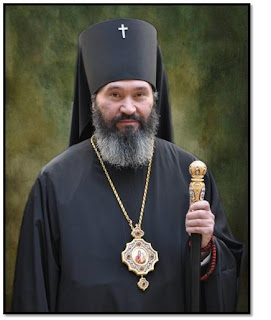 Your Eminences, Graces, dear co-brothers!
Your Eminences, Graces, dear co-brothers!
I sincerely greet all of you as the representative of the Russian Orthodox Church, and would like to convey to you the warmest of well-wishes from His Holiness Kyrill, Patriarch of Moscow and All Russia.
The opening of the Episcopal Assembly of North and Central America coincided with the beginning of my service as Administrator of the Patriarchal parishes in the United States of America. I am glad that, not long after my arrival in this country, I am bearing witness to this inspirational moment of Pan-Orthodox unity and mutual understanding. I hope that our current gathering will lay the foundation for further development of efforts to consolidate Orthodoxy on the American continent.
From what I can tell, the Orthodox in America have reasons for similar hope, considering that in our times Orthodoxy is one of the most dynamically developing Christian confessions on the continent. An increasing number of our faithful belong to the Orthodox Church not as the result of their ethnic background, but of a conscious choice in favor of Orthodoxy’s truth.
This hopeful tendency certainly does not absolve us of our responsibility to bear true witness to the Orthodox faith to the world around us. Each of the Local Orthodox Churches represented here possesses Her own unique experience of missionary, theological, educational, and many other aspects of Church activity on the American continent.
I think that we are all ready to freely share our experiences with our Orthodox brethren. The Russian Orthodox Church, which, as we know from history, played a fundamental role in the expansion of Orthodoxy in America, is ready for this as well. The names of such devoted missionaries as St. Herman of Alaska, St. Innocent of Moscow, and Patriarch Tikhon, are enormously significant to the faithful of every American jurisdiction. It bears mentioning as well, that before the 1920’s, there was only one jurisdiction in North America – that of the Russian Orthodox Church, which, as we know, was open to representatives of the widest variety of ethnic communities.
Much has changed since that time. The tumultuous events of the 20th Century forced many citizens of traditionally Orthodox countries to leave their native homes and seek refuge in other countries, which led to the rise of large ethnic Orthodox communities beyond the boundaries of corresponding Local Churches. Being that America became a welcoming home for a huge number of Orthodox immigrants, She is a shining example of the coexistence of various Church jurisdictions in a single area.
The painstaking discussion of this given aspect of inter-Orthodox relations at the Fourth Pre-Conciliar Pan-Orthodox Conference in Chambésy, Switzerland, in June 2009 speaks to its importance. The result of its work is our current Assembly, which confirms the rightness and viability of the decisions jointly adopted in Chambésy.
It is no secret that the issue discussed in Chambésy invites a great deal of attention, due to the numerous problems and frictions, which, unfortunately, darken the coexistence of Church structures of varying jurisdictions in a single area. We hear of similar complications in the widest variety of other countries and regions. That said, we can take some satisfaction in the fact that the situation in America is not nearly so complex as it is elsewhere. I maintain that this is the case due in no small part to the efforts of the Standing Conference of Canonical Orthodox Bishops in the Americas (SCOBA), which in its time was formed with the active participation of the Russian Orthodox Church. Over the course of its existence since the 1960’s, SCOBA has stepped forward as a fairly effective tool for inter-Orthodox cooperation.
I hope that the positive experience and practical knowledge possessed by the Orthodox bishops of this region will be effectively developed in the future work of the Episcopal Assembly of North and Central America, which will allow us to achieve a new level of coordination of our efforts to unite in our bearing witness to the truth of Orthodoxy.
